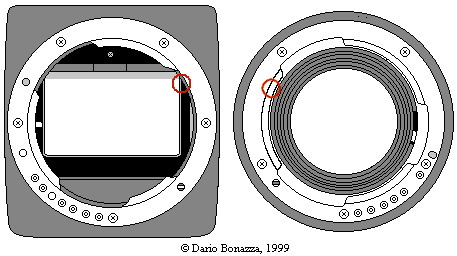Features and Operation of the "crippled" KAF Mount
- Lenses:
- SMC Pentax-FAJ
- Bodies:
- MZ-30/ZX-30, MZ-50/ZX-50, MZ-60/ZX-60, *ist
- Compatibility Issues:
- Bodies in this group are usable with all non-FAJ lenses only when the aperture ring is set to “A”. Setting the aperture ring away from “A” renders all lenses virtually unusable. The FAJ lenses lack an aperture ring and thus appear to be permanently stuck in the “A” setting. This means that they are unusable on bodies capable of only M and Av operation. With most other bodies, the FAJ lenses allow Tv and P operation. The FAJ lenses are fully compatible with all bodies capable of setting the aperture. To the last group belong all Z/PZ bodies as well as all bodies featuring the “crippled” KAF mount.
Overview
The only reason for the existence of this mount variation is cost cutting. This was achieved by leaving out the stop-down coupler of the body mount and the aperture ring of the lens mount. With this move Pentax sacrificed one of its strongest advantages, the unrivaled K-mount compatibility.
The combination of a "crippled" KAF body with any lens functions perfectly if the following two conditions are met:
- The lens that is used has an aperture ring with an “A” setting,
- The “A” setting is engaged.
The combination of a "crippled" KAF lens with any body functions perfectly if the following two conditions are met:
- The body supports P ot Tv operation,
- One of the above settings is selected.
The FAJ Lenses
The FAJ lenses lack aperture rings, and behave as if they are permanently set to the “A” aperture.
The MZ-50/ZX-50 Body
This was the first body that featured the "crippled" KAF mount. When this body detects that the lens aperture is not in the “A” setting or there isn’t such a setting, it meters and exposes the film as if the lens is set to its widest aperture. This allows perfect operation also in the following cases:
- The selected aperture is indeed the widest possible,
- The lens has a manually operating diaphragm,
- The lens has a fixed aperture (for example, it is a mirror lens).
In all other cases, the body underexposes by as many f-stops as the difference between the currently selected f-stop and widest f-stop.
The MZ-30/ZX-30 and MZ-60/ZX-60 Bodies
These "second-generation crippled-bodies" function differently — if they detect that the lens aperture is not in the “A” setting, they do not allow a picture to be taken at all. In this way no underexposed pictures can be taken, but at the same time some very desirable lenses cannot be used at all: all mirror lenses and all lenses with manually-operated diaphragm (for example the 28/3.5 shift or all “soft” lenses).
There is a simple trick that minimizes the limitations of these two bodies and make them behave like the MZ-50/ZX-50. Thanks to Piotr Szuszniak who wrote to me when noticed that his MZ-30 fires the shutter when a screw-mount mounted with the help of a certain non-Pentax screw mount adapter. This was unexpected, because neither the adapter nor the lens have an “A” setting, and yet, it worked! What was special about this combination was the adapter’s surface, which was non-conductive. All Pentax K-mount lenses without an “A” aperture setting have metal mounts, and thus “short” the contacts on the body’s mount. But when the lens mount is non-conductive, the camera behaves as if no lens is mounted at all, and fires the shutter.
Thus, to make the shutter mechanisms of these two cameras fire with lenses without “A” aperture settings, you have to measure which portion of the lens mount lies above the contacts, and then cover it with non-conductive Scotch tape. Michel Carr�re-G�e suggests that masking all contacts is not really necessary — you just have to mask the “*” contact. If you place the camera flat on its back and llok down towards it, the “*” contact is the third one in counter-clockwise direction.
Take care when determining exposure, because the camera’s exposure system now functions exactly like that of the MZ-50/ZX-50.
The *ist Body
This body allows the photographer to choose the camera’s behavior. Leaving the Pentax function 17 set to its default value 0 makes the *ist behave like the MZ-30/ZX-30 and MZ-60/ZX-60. Setting the function value to 1 makes the *ist behave like the MZ-50/ZX-50. While this is not a bad solution, it is still my personal opinion that the whole “crippled” idea was a bad one.
Operation

Figure 1. Diagram of the "crippled" KAF-mount.
The reason for the uncommon behavior of the "crippled" KAF mount is that it is missing the stop-down coupler that is present in every other K-mount variation. The lack of this lever prevents the body from knowing how far down the lens will be stopped during the exposure phase.